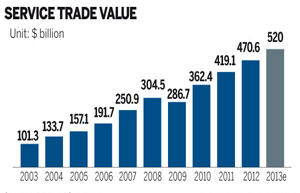Take trade to higher level
By Zhang Monan (China Daily) Updated: 2014-02-18 07:49The tradability of global services is beginning to change the structure of the trade in services. The supply chain of the world's manufacturing sector has experienced a deep restructuring in the first round of globalization, in which, China, by taking advantage of its cheap production factors, has accumulated an enormous current account surplus. Against the backdrop that the world's multinationals have basically sharpened their manufacturing edge and that China's traditional development dividends are gradually disappearing, the country should accelerate the upgrading and transformation of its trade structure as soon as possible.
As the country's demographic dividend is on the ebb and the growth of its labor supply is on the decline, its labor costs will surely soar. In this context, the profit margin of the country's industrial sectors will become thinner, their capital return ratio will fall and export-driven growth dividends will decline.
With the decline of its "resources dividend", China's economic growth will face a resources and environmental bottleneck. The country's decades-long extensive economic growth model, which is excessively built on industrialization, exports and investment, has seriously threatened its sustainable development and resources and constraints have become increasingly evident.
The evolution of the global economic growth pattern also highlights the urgent need for China to upgrade its services trade. With the reversal of global imbalances, the increasing costs of labor and resources and growing pressures for exchange rate appreciation of the yuan, along with other factors, China will face growing difficulties if it continues to depend on exports as the main driving force for economic growth in the future. That means it is difficult for China to continue depending on its previous low-cost advantages in labor, land, resources, environment and other production factors to participate in the international division of labor and competition and thus difficult for it to achieve some breakthroughs in its trade level and strategic interests. At the same time, if it stays at the low end of the global industrial chain the country will possibly acquire a fixed identity among the world's consumers.
It will be an irreversible trend for China to transform from a factors-driven to efficiency-driven economy in the future. Thus, it should gradually reverse the past growth model based on competition among primary factors, vigorously develop a higher-level services trade and push for the upgrading of its whole industrial chain.
The author is an associate research fellow with the China Center for International Economic Exchanges.
|
 |
 |
- NHTSA says finds no 'defect trend' in Tesla Model S sedans
- WTO rare earth ruling is unfair
- Amway says 2014 China sales may grow 8%
- President Xi in Europe: Forging deals, boosting business
- CNOOC releases 2013 sustainability report
- Local production by Chery Jaguar Land Rover this year
- Car lovers test their need for speed in BMW Mission 3
- China stocks close mixed Monday

















